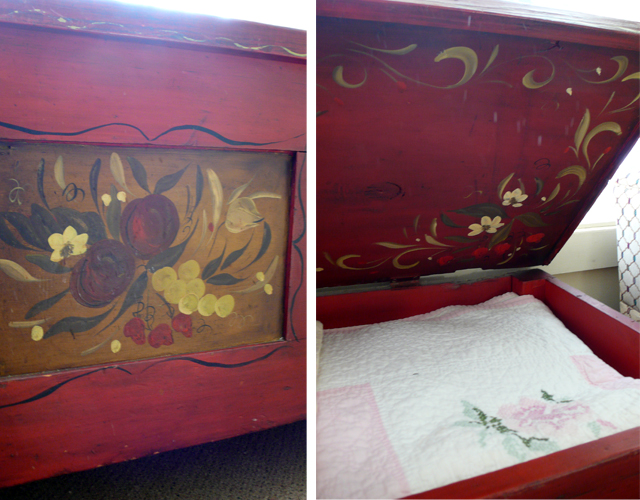
This post could also be called Pennsylvania Dutch BiniChic, since it is an ode to our family treasures and how they fit into the BiniChic philosophy.
Aunt Jean’s home is like a treasure chest. Every niche and cranny is filled with little morsels of history — sometimes delicious, others kitsch — but always interesting. On our last visit this November, my mother and I dove into her Hope Chest and her Magic Basement, where we found countless and meaningful objects.
I have always felt I came from a family of artists — my father, my mother, my paternal grandmother, cousins, uncles — mostly everybody in my family is a designer or artist of some kind. My mother, however, comes from a family of writers, engineers, teachers and lawyers, making her the first artist in her family. Or so I thought.
The above is a detail of one of the many quilts designed and hand-stitched by my great-grandmother Lukzus — my mother’s maternal grandmother. She wasn’t an artisan by profession, but her work is creative, playful and perfectly finished. I am told she was also a master seamstress and made sure her daughters and grandchildren were impeccably dressed. She was the original BiniChic — using simple and yet wonderfully colored cotton to make priceless quilts and clothing that have lasted many generations.

My mother inherited her eye for beautiful color combinations and an attention to the detail and finishes that give something its true quality. I am ecstatic to think that such treasures — many over 60 years old — survive intact into this day, and that they were made in my own family.

The wonderful quilts were kept in a Hope Chest crafted in the original Pennsylvania Dutch style in the 1960s. Hand painted in Lancaster, my mother had taken one just like Aunt Jean’s to Menorca, and it has been in S’Olivera since before I was born. The chest is decorated with fruits and flowers in a style very characteristic of Pennsylvania Dutch. Regardless of its northern origins, it has a very rustic, Mediterranean air.

Cowden & Wicox are stoneware vases made in Harrisburg, Pennsylvania between 1854 and 1924. They are now very prized possessions, not only for their beauty, but for their extreme rarity. Their beautiful cobalt floral design pops out on a brown and taupe background. If they didn’t have a large engraving on its upper edge with their city of origin, they could easily pass as a traditional stoneware of the Mediterranean.

You can find BiniChic around the corner — or on the other side of the world. It can be something that you always knew, or something that you always looked over. BiniChic is not only the mix of the rustic with the designed, it is also being able to look at everything with a fresh vision — taking it out of context and re-imagining it. Even if its profoundly Pennsylvania Dutch.



